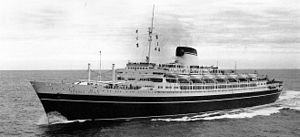
Back Transatlàntic Andrea Doria Catalan SS Andrea Doria Czech SS Andrea Doria Danish Andrea Doria (Schiff, 1953) German Andrea Doria (1953) Spanish SS Andrea Doria Finnish Andrea Doria Faeroese Andrea Doria (paquebot) French אנדריאה דוריה (אונייה) HE SS Andrea Doria Hungarian
This article needs additional citations for verification. (February 2023) |
 Andrea Doria at sea
| |
| History | |
|---|---|
| Name | SS Andrea Doria |
| Namesake | Andrea Doria |
| Owner | Italian Line |
| Operator | Italian Line |
| Port of registry | Genoa, Italy |
| Route | Genoa - New York City |
| Builder | Ansaldo Shipyards of Genoa, Italy |
| Yard number | 918 |
| Launched | 16 June 1951 |
| Maiden voyage | 14 January 1953 |
| In service | 14 January 1953 |
| Out of service | 26 July 1956 |
| Fate | Sunk on the night of 26 July 1956 after colliding with MS Stockholm; 46 deaths |
| General characteristics | |
| Class and type | Andrea Doria-class ocean liner |
| Tonnage | 29,083 GRT |
| Length | 213.80 m (701 ft 5 in) |
| Beam | 27.50 m (90 ft 3 in) |
| Draft | 30 ft (9.1 m) |
| Decks | 10 |
| Installed power | Steam turbines |
| Propulsion | Twin propellers |
| Speed | 23 knots (43 km/h; 26 mph) |
| Capacity | 1,241 passengers |
| Crew | 560 |
SS Andrea Doria (pronounced [anˈdrɛːa ˈdɔːrja]) was a luxury transatlantic ocean liner of the Italian Line (Società di navigazione Italia), put into service in 1953. She is widely known from the extensive media coverage of her sinking in 1956, which included the remarkably successful rescue of 1,660 of her 1,706 passengers and crew.
Named after the 16th-century Genoese admiral Andrea Doria, the ship had a gross register tonnage of 29,100 and a capacity of about 1200 passengers and 500 crew. Of all Italy's ships at the time, Andrea Doria was the largest, fastest and supposedly safest. Launched on 16 June 1951, she was home-ported in Genoa, and began her maiden voyage on 14 January 1953.
On 25 July 1956, the New York City–bound vessel was approaching the coast of Nantucket, Massachusetts, United States, when the eastbound passenger liner Stockholm of the Swedish American Line collided with her. Struck in her starboard side, the top-heavy Andrea Doria immediately started to list severely that way as she took on water, which left half of her lifeboats unusable. The consequent shortage of lifeboats could have resulted in significant loss of life, but the ship stayed afloat for over 11 hours after the collision.[1] The calm, appropriate behavior of the crew, together with improvements in communications, and the rapid response of other ships, averted a disaster similar in scale to that of Titanic in 1912. While 1,660 passengers and crew were rescued and survived, 46 people on the ship died as a direct consequence of the collision.[2] The evacuated luxury liner capsized and sank the following morning. This accident remains the worst maritime disaster to occur in United States waters since the capsizing of the Eastland in Chicago in 1915.[3][4]
While the rescue efforts for both ships were successful, the cause of the collision, culpability, and the loss of Andrea Doria generated much continued interest in the media and many lawsuits. Largely because of an out-of-court settlement agreement between the two shipping companies during hearings immediately after the disaster, no determination of cause was ever formally published.
- ^ Samuel Halpern, An Objective Forensic Analysis of the Collision Between Stockholm and Andrea Doria
- ^ "PBS Online – Lost Liners – Comparison Chart". PBS.
- ^ "Hunting New England Shipwrecks". Wreckhunter.net. Retrieved 1 May 2012.
- ^ "The exclusive economic zone is the zone where the U.S. and other coastal nations have jurisdiction over economic and resource management". NOAA. Retrieved 1 May 2012.
© MMXXIII Rich X Search. We shall prevail. All rights reserved. Rich X Search